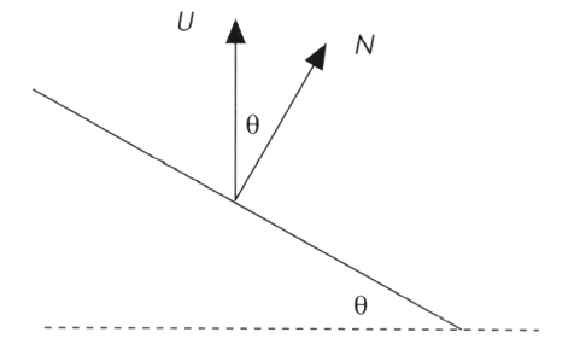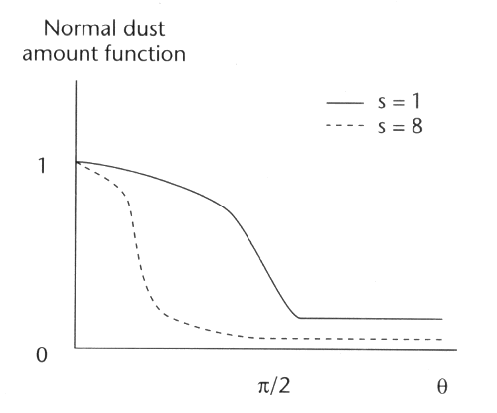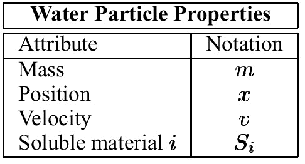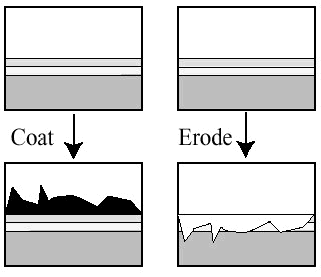| Dust | Stains |
 [16] [16] |
 [7] [7] |
 [10] [10] |
 [5] [5] |
CS 563 Advanced Topics in
Computer Graphics
Surface Imperfections
by Curt Ferguson
Introduction to Surface Imperfections
Surface imperfections are the small flaws that exist on real objects. Dorsey and Hanrahan classify surface imperfections as "[D]irt and dust, cracks and scratches; a dribble of rust down a wall from a leaky pipe; a patchy green patina of oxidation on a copper statue; the salt-crusted, weather-beaten face of an ancient granite sphinx; the fine tones of human skin, complete with freckles, pores, wrinkles and a slight flush of living blood." [4]
Why use Surface Imperfections
The appearance of many natural surfaces contain surface imperfections. Images without imperfections lack realism, with the objects commonly containing a plastic like appearance, and the scene looking to clean. Virtual weathering is used to increase the realism of a scene by introducing the flaws that exist in nature.
Prior Knowledge
Rendering of surface imperfection makes use of many previously developed techniques.
Overview
The Accumulation of Dust
The distribution of dust is calculated by considering the normal and external factors of its distribution. Normal factors for dust accumulation are the angle of inclination for an object's surface, and the surface's stickiness. External factors that can influence the amount of dust on a surface are how exposed the surface is, and if it can be scraped by other objects.Normal Factors
The normal dust accumulation function is expressed as
where Ø = the angle between surface normal N and gravitational up vector U. An constant factor K is used to model general dust adhesion. S is the surface slipperiness, and includes the inclination angle of the surface to determine how much dust will stick.
 |
 [16] [16] |
External Factors
where
Surface Exposure
is the number of emitted random rays.
the distance between the dust position and the ith ray intersection point
a user-defined constant (half-exposure distance)
Scraping effect
where
Changes in appearance caused by flowing water
Stained objects are represented through flow models and particle systems. Flow models consider the flow and change of surface appearance by modeling water. These models can be used in the animation of water from particle interaction, and uses wetness maps to store the saturation values of the object. The particle system techniques is uses to model individual droplets of water over time, and can easily be applied to three dimensions. This allows it to consider droplets that are absorbed into the material, and are no longer on the surface.
Absorption of water - common terms
This image shows how several materials absorb varying amounts of water, based on time and the material characteristics.
[7]
Staining of surfaces
Dirt or rust particles are redistributed by flow of water. From water running over high flow areas, the material is washed clean. Re-deposition of the colored particles occurs where runoff stops or slows enough for the particles to stay. Backsplash (a process where water hits the ground, splashing dirt and rust back onto the object) is also considered.
[7]
Absorption and Deposition
The absorption of water by the surface and sedimentation of loose deposits 
[7]
Example - Venus de Milo
Particle information is used to calculate the dirt redistribution.
[7]
The appearance of wet materials
Wet materials are considered surface imperfections, as the material properties change from the presence of water. A material can appear darker, brighter, or more specular. As with the particle system used for stains, water particles can be located as a layer on the surface or inside the material. [10]Characteristics of wet materials
Water on the surface
Water on a surface can make the material appear shinier or darker. The increased specularity of the surface results from a smooth air-water interface being formed. Fresnel’s equations for dielectric media are used to model this transition of light from one media to the next. The reflection of light is also influential, and a surface can appear darker due to total internal reflection at the air-water boundary. This is caused by the light being trapped under the water, reflecting downward each time it hits the air-water boundary.
[10]
Water inside material
On rough or powdery materials, water flows into the air spaces of the material. This changes the scattering properties of the material due to the index of refraction of water being higher than air. The BRDF of the material has changed, with a light ray having a much greater change of bouncing deep into the object or out the other side. Shown below are before and after examples of light rays entering the material. The ray for a) enters the dry material, which has a greater chance to reflect the ray equally in all directions. The ray b) enters the wet material, and the properties of water cause it to have a greater chance of reflecting in its original direction. Ray b) requires greater collisions to exit the material on the same side it entered.
[10]
Two-layer Surface Reflection Model
These equations are used to solve for the two transition interface layers. The three materials n1, n2 and n3 change the light ray's direction through surface reflection for refraction.

[10]
Phase function
Materials are represented as two-term Henyey-Greenstein phase functions.
[10]
[10]
Example - Paper
Change of phase function on a matte material. The paper on the left has the viewpoint and light source on the same side. The spot in the middle of the paper illustrates that more light passes through the wet material. The right image has the light source behind the paper, so again more light passes through the wet material while reflecting off the dry paper.
[10]
Metallic and stone patinas
Patinas are "The sheen on any surface, produced by age and use." [1] A patina is a film or encrustation on a surface that is produced by chemical alteration, addition, or removal of material. Natural patina’s are caused by atmospheric corrosion, tarnishing metals.
|
 |
Modeling
Patina's are modeled by adding or eroding layers of the surface. These layers are stored in thickness maps. To create the random appearance which naturally occurs, a fractal growth model is used to administer the addition or removal of material. The patina generation starts off with an unaltered material a). In b), the surface interacts with water or a chemical. By c), a chemical reaction has occurred at the surface, altering the surface material. This new material d) may be weaker that the original, and wear away.
[6]
Rendering
For rendering of a single layer patina, the Kubelka-Munk model is used [5]. It generates an approximate BRDF’s during rendering.
[5]
Summary
All of these techniques are useful for modeling real world effects, and adding realism to scenes.The addition of surface imperfections to the rendering process are the increased realism of the scenes, and a reduction of the effort needed to make a scene that looks believable. Toy Story is cited as one of the defining examples in animation[4], but to achieve weathered looks each texture had to be brushed by the artist. Using traditional texture mapping techniques to create the appearance of dusty or scratched surfaces requires a lot of manual adjustment and is difficult to apply to irregularly shaped objects. Furthermore, such methods cannot automatically deduce the distribution of dust on different parts of an object. The virtual weathering aspect of surface imperfections can be used to predict how materials will look in the future and over time.
The disadvantages of rendering surface imperfection are that while they may achieve some effects of realism, they are not exactly physically accurate. Real world weathering is not fully understood, which makes accurate models impossible. Further, these models are computationally expensive, and requiring even more calculations to render an image are usually not feasible.
Conclusion
By choosing which imperfections to include, materials with the appearance of natural surfaces can be achieved. While increasing the rendering process, surface imperfection modeling allow scenes to achieve increased realism and can be applied to any desired object.
References
[1] Atomica.com Instant web reference 2003
[2] James F. Blinn. "Light reflection functions for simulation of clouds and dusty surfaces," Proceedings of the 9th annual conference on Computer graphics and interactive techniques, p.21-29, July 26-30, 1982, Boston, Massachusetts
[3] Robert L. Cook, Kenneth E. Torrance. "A reflectance model for computer graphics", ACM SIGGRAPH Pages: 307 - 316 1981
[4] Julie Dorsey, Patrick M. Hanrahan. "Digital Materials and Virtual Weathering," Scientific American.com. February 2003.
[5] Julie Dorsey, Patrick M. Hanrahan. "Modeling and Rendering of Metallic Patinas," Proceedings of SIGGRAPH 96. pp. 387-396, 1996.
[6] Julie Dorsey, Alan Edelman, Henrik W Jenses, Justin Legakis, Hans K Pedesen. "Modeling and Rendering of Weathered Stone" Proceedings of SIGGRAPH 99. 1999.
[7] Julie Dorsey, Hans Køhling Pedersen, Patrick M. Hanrahan. "Flow and Changes in Appearance," Proceedings of SIGGRAPH 96. pp. 411-420, 1996.
[8] Pat Hanrahan , Wolfgang Krueger. "Reflection from layered surfaces due to subsurface scattering," Proceedings of the 20th annual conference on Computer graphics and interactive techniques, p.165-174, September 1993
[9] Xiao D. He , Kenneth E. Torrance , François X. Sillion , Donald P. Greenberg. "A comprehensive physical model for light reflection," ACM SIGGRAPH July 1991
Volume 25 Issue 4[10] Jensen H.W., Legakis J and Dorsey J, "Rendering of Wet Materials", Proc. Eurographics Workshop on Rendering, June 1999, pp. 273-282
[11] Henrik Wann Jensen , Stephen R. Marschner , Marc Levoy , Pat Hanrahan. "A practical model for subsurface light transport," Proceedings of the 28th annual conference on Computer graphics and interactive techniques, p.511-518, August 2001
[12] Eihachiro Nakamae , Kazufumi Kaneda , Takashi Okamoto , Tomoyuki Nishita. "A lighting model aiming at drive simulators," ACM SIGGRAPH Computer Graphics , Proceedings of the 17th annual conference on Computer graphics and interactive techniques September 1990 Volume 24 Issue 4
[13] William T. Reeves, Ricki Blau. "Approximate and probabilistic algorithms for shading and rendering structured particle systems," ACM SIGGRAPH ACM Press New York, NY, USA p 313 - 322 1985
[14] Holly E. Rushmeier , Kenneth E. Torrance. "The zonal method for calculating light intensities in the presence of a participating medium," ACM SIGGRAPH Computer Graphics, v.21 n.4, p.293-302, July 1987
[15] Stephen H. Westin , James R. Arvo , Kenneth E. Torrance. "Predicting reflectance functions from complex surfaces," ACM SIGGRAPH July 1992 Volume 26 Issue 2
[16] Siu-Chi Hsu and Tien-tsin Wong, "Simulating Dust Accumulation", IEEE Computer Graphics and Applications 1995 (15)1: 18-25